#varanosuchus
Text
Varanosuchus: First Fossil Croc of 2024
We are two weeks into the year and we already had a bunch of big croc papers, so today I'll cover the first of the two new genera named so far.
Varanosuchus sakonnakhonensis (Monitor lizard crocodile from Sakon Nakhon) is a small atoposaurid neosuchian from the Early Cretaceous of Thailand, a country that has seen a virtual boom in croc papers this past year between the description of Alligator munensis and Antecrocodylus.
Varanosuchus was a small animal, maybe a meter in length if a little longer with a notably short and deep skull and long slender limbs revealing it to have been at least somewhat terrestrial. We actually have a decent amount of material of this guy. The holotype consists of a 3 dimensionally preserved skull as well as assorted postcranial remains (vertebrae, ribs, osteoderms and limbs), there is a second skull of whats likely to be a differently aged individual also showing a 3D skull and well the third ones just a skull table but 2/3 is still great.
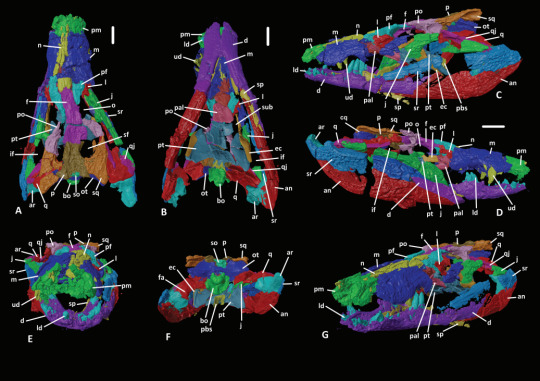

Now this guy was an atoposaurid, which is a group of crocodylomorphs that lived from the Jurassic to the end of the Cretaceous, their last members existing on the island of Hateg some 66 million years ago. Atopsaurids were generally small animals with short snouts and longish legs. Some examples of atoposaurids include Knoetschkesuchus from Germany, Aprosuchus from Romania and Alligatorellus from France and Germany, all three pictured below, art by @knuppitalism-with-ue
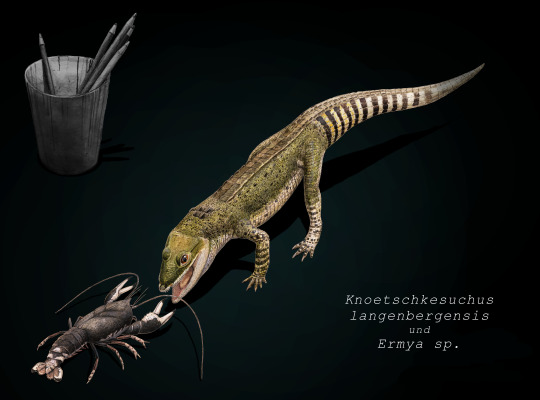
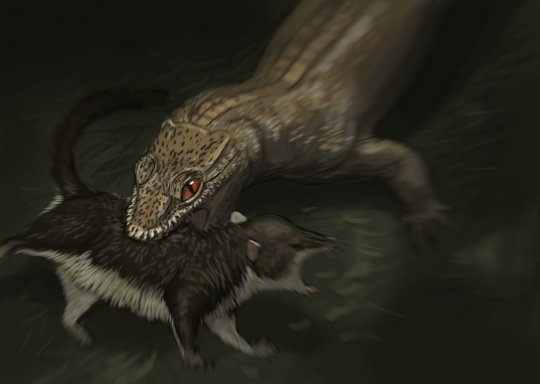
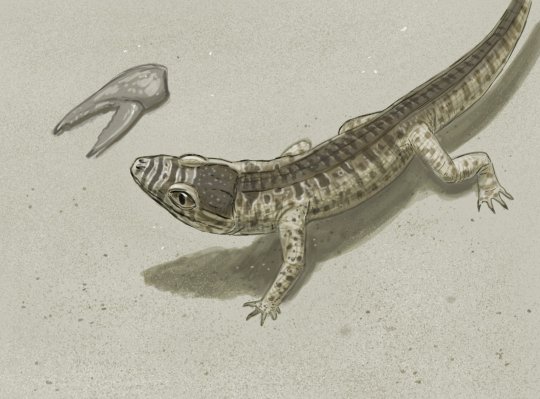
Now the matter of ecology for atoposaurids in general and Varanosuchus in particular is not clear. Altirostral skulls such as that of Varanosuchus are generally associated with terrestrial crocodylomorphs as best examplified by notosuchians. Their teeth and size both obviously speak against being shoreline ambush predators like modern crocs and their legs are straight and slender, suggesting they had an erect posture and not the more sprawling one seen in semi-aquatic forms. Though they could have still had some aquatic affinities. The authors for instance argue that the osteoderms, having plenty of pits, are more like those of an animal that spends time in the water and would thus use them in thermoregulation. So maybe they did enter water from time to time, somewhat like some modern lizards, tho I think its fairly certain that they spend a decent amount of time on land. The artwork below is the reconstruction from the paper itself.
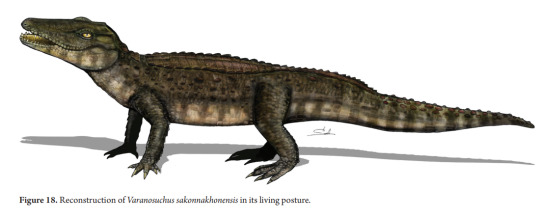
Another matter discussed in the paper is phylogeny, more precisely the relationship of Neosuchians and how Eusuchia is defined. On the first front, its worth noting that the paper recovered both atoposaurids and paralligatorids as monophyletic groups and had them be each others closest relatives, a notion that has been recovered before. More interesting perhaps is the fact that the next closest relatives to these two were hylaeochampsids and Bernissartia, which are typically recovered closer to modern crocs. Which in fact form a separate branch that is the sister group to all the afforementioned clades and taxa. And then you got goniopholids, dyrosaurs and pholidosaurs which are all more basal than the paralligatorid+atoposaurid+crocodilian group, which is back to the ordinary really. The second thing is the definition of Eusuchia. So for the longest time Eusuchia has been defined to include those Neosuchians that have choanae that are fully enclosed by the pterygoid bones (I know I know a bunch of anatomy stuff bear with me). So if the choanae was surrounded by the pterygoid, its an Eusuchian, if not, its more basal. Well, atoposaurids don't have that....BUT VARANOSUCHUS DOES. This, coupled with hylaeochampsids also having this feature and being recovered closer to atoposaurids than to Crocodilians basically suggests that the feature is not diagnostic for Eusuchia and instead appeared multiple times independently.
Moving away from anatomy and phylogeny and all that stuff, I think its very cool that croc research in Thailand has kinda picked up this last year. And fittingly enough some people have even worked on a short documentary covering the known diversity of pseudosuchians from Thailand, giving an overview over the named forms from the Jurassic to today, from titans like Chalawan to even these newest dwarf forms. While the narration is obviously in Thai, there are English subs and I highly recommend looking into it (even if I disagree with their depiction of Varanosuchus as arboreal, its perhaps overshooting the goal a little bit).
youtube
Finally here's the paper itself (tho paywalled)
New Cretaceous neosuchians (Crocodylomorpha) from Thailand bridge the evolutionary history of atoposaurids and paralligatorids | Zoological Journal of the Linnean Society | Oxford Academic (oup.com)
and the wikipedia page I've been working on
Varanosuchus - Wikipedia
I'll try to write up a post on the other new genus, Garzapelta, later this weekend so stay tuned for that.
#varanosuchus#atoposauridae#crocodylomorpha#neosuchia#thailand#cretaeous#pseudosuchia#croc#crocodile#land crocodile#prehistory#paleontology#palaeblr#long post#Youtube
192 notes
·
View notes
Text
Pseudosuchians described in 2024 #1 Varanosuchus sakonnakhonensis

First of a series of quick sketches that I´ll try to do for each pseudosuchian that will be published throughout 2024 (I don't promise that I'll do all of them).
I will give priority to everything that is closer to the crown group of the current crocodilians, although if I get too motivated I might even include phytosaurs, although I doubt it extremely.
And yes, Im informed about Garzapelta, and I take this opportunity to say that I am sorry to all the aetosaurs´s fans, but these are totally excluded from the series because they are, objectively speaking, not only the most tedious tetrapod group to draw, but also the most boring looking (The truth hurts, I know).
Now I could give a description of what Varanosuchus is and all that, but as usual, Armin has done it faster and better, so go and read his instead
31 notes
·
View notes
Text
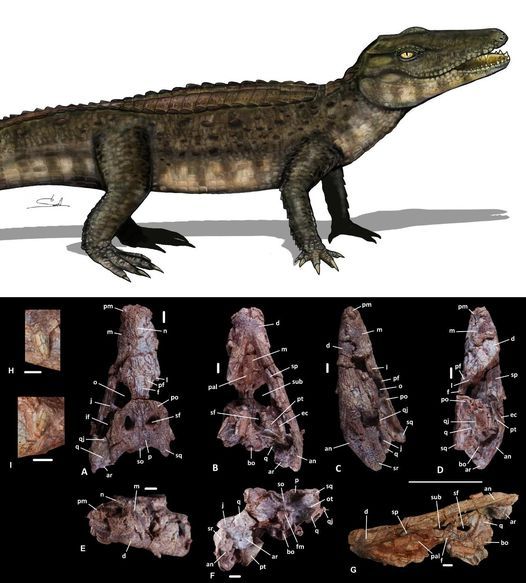
New Cretaceous neosuchians (Crocodylomorpha) from Thailand bridge the evolutionary history of atoposaurids and paralligatorids
Yohan Pochat-Cottilloux, Komsorn Lauprasert, Phornphen Chanthasit, Sita Manitkoon, Jérôme Adrien, Joël Lachambre, Romain Amiot, Jeremy E Martin
Abstract
The origin of modern crocodylians is rooted in the Cretaceous, but their evolutionary history is obscure because the relationships of outgroups and transitional forms are poorly resolved.
Here, we describe a new form, Varanosuchus sakonnakhonensis gen. nov., sp. nov., from the Early Cretaceous of Thailand that fills an evolutionary gap between Paralligatoridae and Atoposauridae, two derived neosuchian lineages with previously unsettled phylogenetic relationships.
Three individuals, including a complete skull and associated postcranial remains, allow for a detailed description and phylogenetic analysis. The new taxon is distinguished from all other crocodylomorphs by an association of features, including a narrow altirostral morphology, a dorsal part of the postorbital with an anterolaterally facing edge, a depression on the posterolateral surface of the maxilla, and fully pterygoid-bound choanae.
A phylogenetic analysis confirms the monophyly and taxonomic content of Atoposauridae and Paralligatoridae, and we underline the difficulty in reaching a robust definition of Eusuchia.
Furthermore, we put forward further arguments related to the putative terrestrial ecology with semi-aquatic affinities of atoposaurids based on their altirostral snout morphology and osteoderm ornamentation.
Read the paper here:
https://academic.oup.com/zoolinnean/advance-article-abstract/doi/10.1093/zoolinnean/zlad195/7513556
19 notes
·
View notes
Text
Garzapelta: The Convergent Aetosaur
Our second pseudosuchian of 2024 couldn't be any more different from the first. While the first genus named this year was Varanosuchus, a small, agile atoposaurid from the Cretaceous, our second genus is Garzapelta (Garza County Shield), a large lumbering aetosaur, basically the ankylosaur of the Triassic.
If you remember the two posts on aetosaurs I did last year, you probably remember how osteoderms are super diagnostic for these guys and how the material doesn't need to be all that exciting to represent a new genus. In the case of Garzapelta its kind of an intermediate. It's better than the handfull of osteoderms we got for Venkatasuchus and Kryphioparma but its still mostly just osteoderms and some ribs (and a single toe bone).

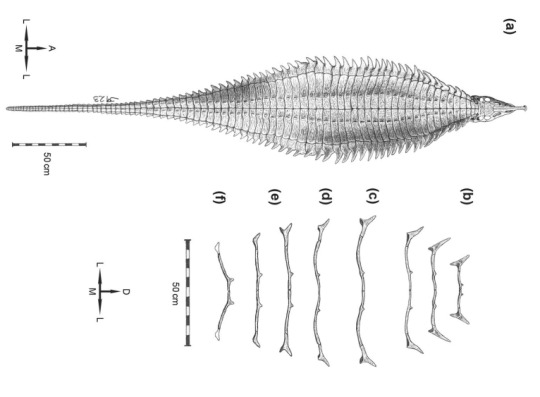
Now the thing that stands out about Garzapelta is the specific combination of characters displayed by the osteoderms. So if you take a step back and look at aetosaurs as a whole, you'll see two big groups that split off from one another. The stagonolepoids, which eventually gave rise to the overly spiky desmatosuchines, and the aetosaurines, which gave rise to some really wide paratypothoracines. Shown below Desmatosuchus and Paratypothorax (not to scale), taken from Martz et al. 2013 and Heckert et al. 2010

But this doesn't yet say why Garzapelta is special. Well you see. We got both the paramedian osteoderms (the central two rows) and the lateral osteoderms (those spikes on the side). Now, the lateral osteoderms are morphologically really similar to those of desmatosuchines, HOWEVER, the paramedian osteoderms more closely resemble those of paratypothoracines. This is so extreme that when writing the paper, Reyes and colleagues did separate phylogenetic analysis for both osteoderm types. And as you might have guessed, when just looking at the laterals it was recovered as a desmatosuchine, but when looking at the paramedians it was recovered as a paratypothoracine (or rather something close to said groups). And when looking at both at the same time....well still a desmatosuchine.
Ironically, despite this, the authors don't think it was a desmatosuchine. Instead, the way the lateral and paramedian osteoderms connect is way more similar to paratypothoracines and ultimately the authors argue that its way more likely that the shape of the lateral osteoderms is the thing that evolved convergently. This whole situation does however highlight a major thing. Current datasets aren't really ready to deal with convergence like this.
And thats all I got to say about this one. Not as extensive as little Varanosuchus I know, but its surprisingly much given its just a bunch of osteoderms and not much in terms of skull remains or anything like that.
65 notes
·
View notes